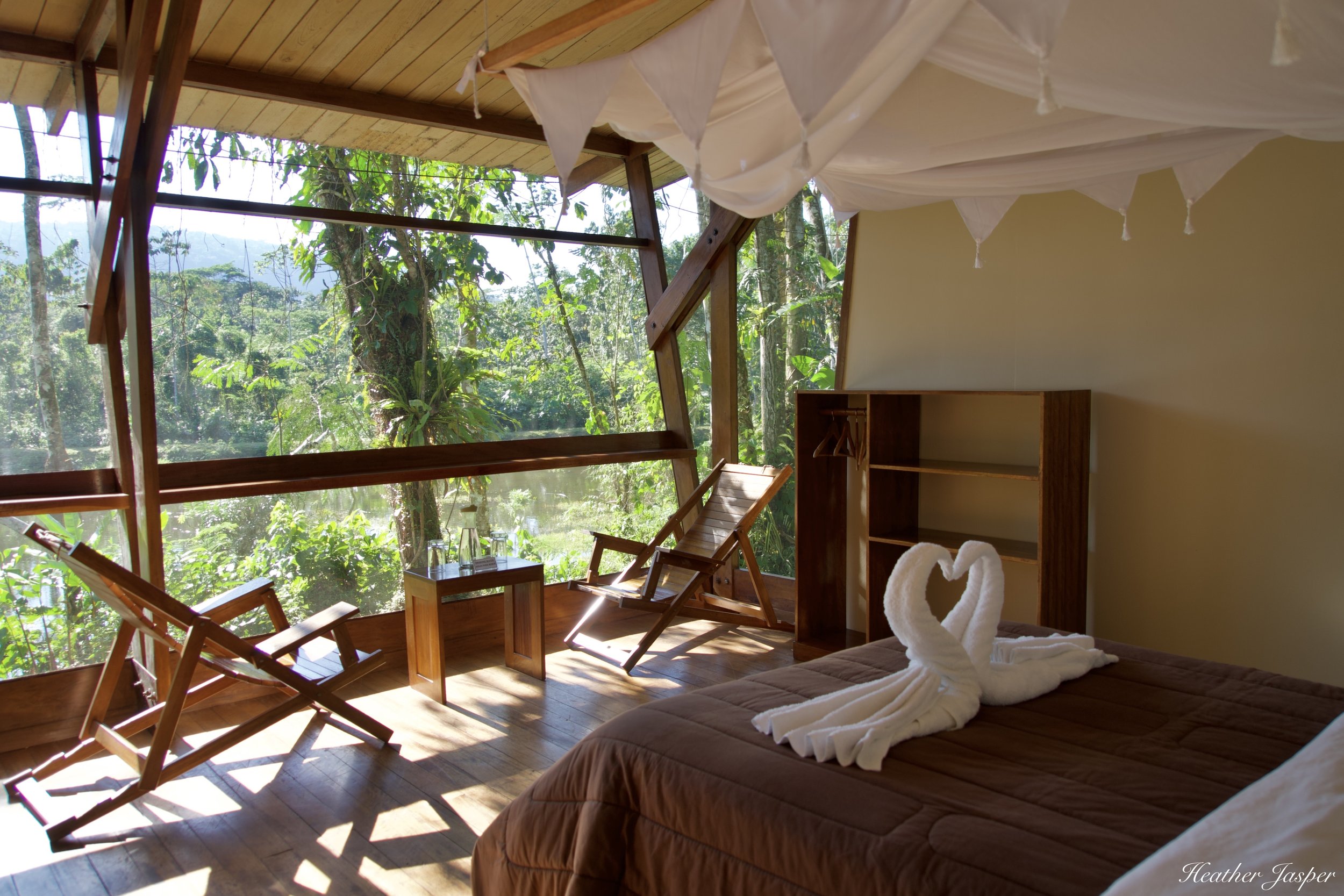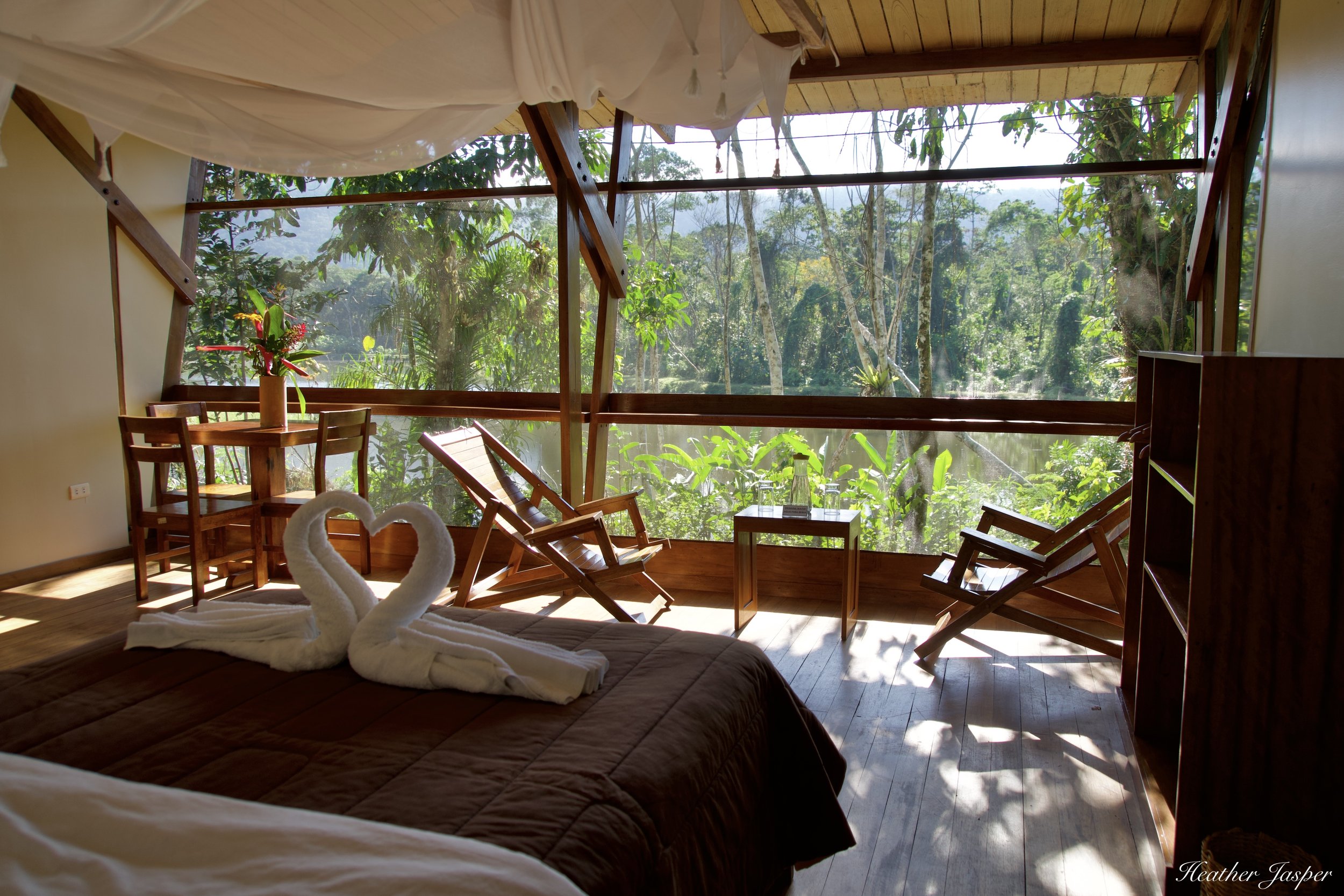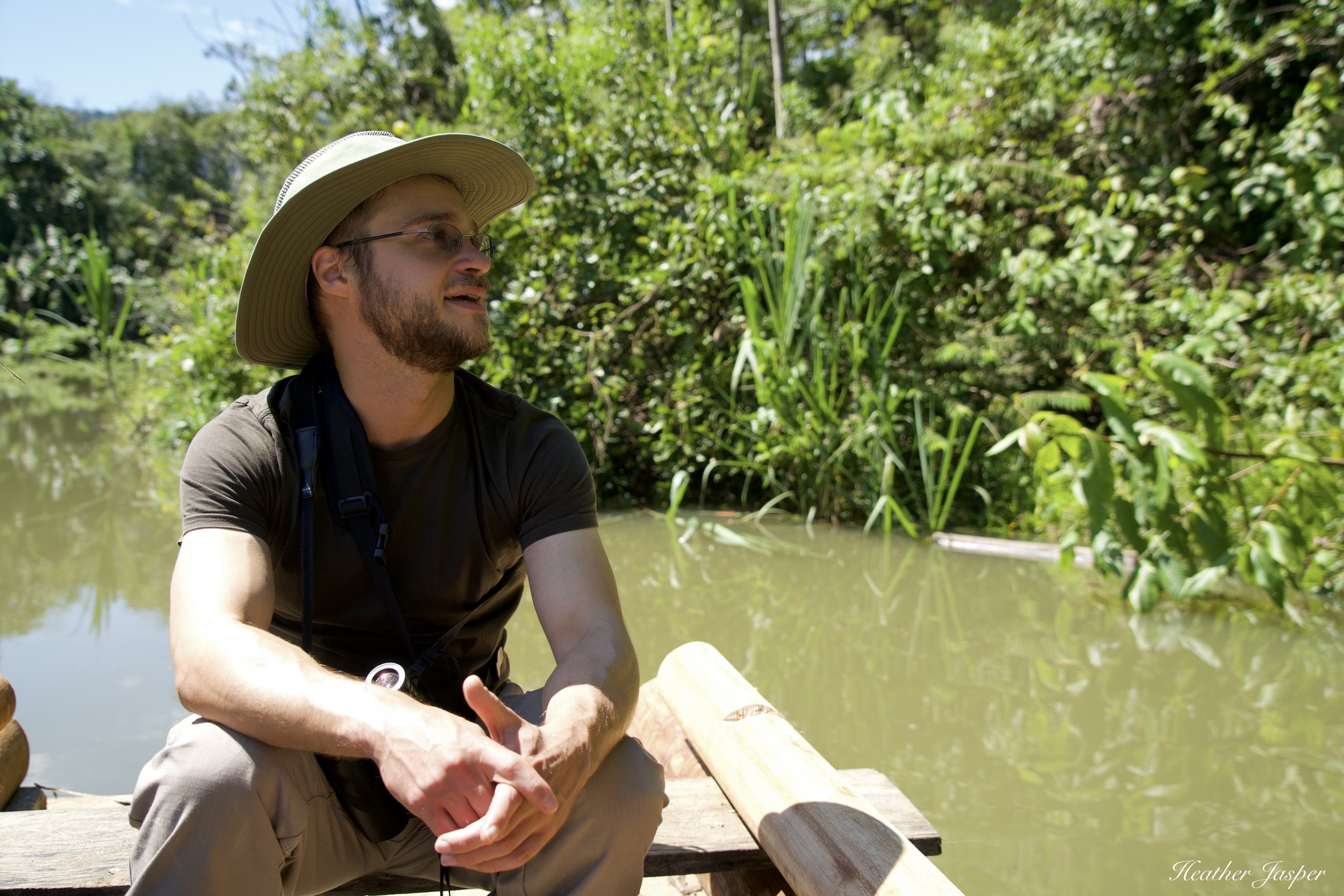Manu BioLodge
Manu BioLodge & BioStation
A fantastic spot for birding, the Manu BioLodge is a non-profit that supports the Manu BioStation’s scientific research and conservation work.
The Manu BioLodge is a recent rebranding of the famous Villa Carmen, which is known worldwide for its rich and diverse bird populations. So far, 659 bird species have been identified on the 7,600 acres of nature preserve. It’s not that hard to see a hundred species in a day. I easily saw ten to twenty species from my cabin in the morning before breakfast. There was another ten to twenty that I saw every morning from the dining hall during breakfast. That made up to forty species before 8am without even going on any of the trails. (My full bird list is at the end of the blog).
The trail system was one of the things I loved most at Manu BioLodge. There are a dozen trails that cover over 25 miles / 40km and go through several different kinds of forest, plus rivers and lakes. I downloaded the Avenza Maps app so I could see the trail map on my phone. The app showed me where I was on the trail system, even when I didn’t have cell service or wifi. It’s very accurate and works the same even if your phone is in airplane mode.
The land was previously logged and used for agriculture, making this one of the most important places for conservation work and research on how species recover. The birds have been the first to return and camera traps have taken photos and video of jaguars, pumas, and other big mammals on the property. The monkeys are slower to return, but I saw a few Yellow-tailed Woolly Monkeys near the river. They were moving fast through the top of a bamboo forest, so I couldn’t tell how many there were. Those were the only monkeys I saw there.
The lodge opened in 2018 and some of the animals that camera traps have captured images of are: agouti, armadillos, pumas, deer, peccary, tapirs, capybaras, pacas, tayras, 3 toed sloths, and anteaters.
The Hoatzin
Hoatzins (above) are one of the strangest birds on the planet. They are ruminants, which means that their stomach is like a cow’s. Their blue faces and awkward squawking always reminds me of dinosaurs. I have yet to see one of their chicks, but they have claws on their wings to climb up trees. I also have not gotten close enough to smell one, but they are famous for smelling terrible. My bird book calls them “sluggish, ungainly and clumsy” and I couldn’t agree more.
The Hummingbirds
There are dozens of species of hummingbirds in Manu but the two above were some of the most common amongst the flowers by the dining hall. The top one is a Gould’s Jewelfront, and if you can spot the purple patch on the forehead in the left and middle photos, you’ll understand the name. As you can see in the photo on the right, you have to see the Jewelfront from the right angle to catch the flash of amethyst feathers. Click on the photo to see it enlarged.
The bottom hummingbird is a Gray-breasted Sabrewing. They’re easy to recognize not for their colors but for their habit of keeping their wings raised for a split second after they perch.
Other hummingbirds I saw were Golden-tailed Sapphire, White-necked Jacobin, Blue-tailed Emerald, White-bearded Hermit, White-browed Hermit, Blue-chinned Sapphire, Fork-tailed Woodnymph, Rufous-breasted Hermit, Green-fronted Lancebill, Rufous-crested Coquette, and Sapphire-spangled Emerald.
The Rufescent Tiger-heron
Though classified as uncommon, I saw both the juvenile (left) and adult (right) Rufescent Tiger-herons every morning. I watched them from my cabin before breakfast and they were often still there later in the day.






My Cabin at Manu BioLodge
The Manu BioLodge is an incredible place to stay if you want to see birds in the Peruvian Amazon. The cabins are perched at the edge of a lake that’s always full of birds. They’re very comfortable and a great spot for birdwatching.
I loved that the whole wall of my cabin that faced the lake was screen. As long as I was quiet, the birds didn’t notice me at all. It was like living in a bird blind, except the mosquitoes couldn’t get at me. If the trail system wasn’t so fantastic, I could happily have spent all day in the cabin.
Crossing the Piñi Piñi
The trail system is mostly on the near side of the Piñi Piñi River, but you can cross the river on the cable car to explore an area that sees even fewer people.
Your stay at Manu BioLodge supports conservation & science.
Another perk of staying at a lodge that supports a research station was getting to interact with the scientists who are conducting research there. I learned about a team researching vultures and their role in the local ecosystem, a PhD student studying bird calls, a researcher studying vectors for the leishmaniasis parasite and a team sequencing the DNA of animals at the station by using the stomach contents of dung beetles.
Everybody there was very friendly, from the cooks and staff to researchers and administrators. They all genuinely loved their jobs and living in the jungle. It was so much fun to meet them and hear their stories. I plan to go back on March 8th for a women’s birding event hosted by Juliana Andrea Morales. Find out more about her event on Instagram @wbd_manubiostation
Research on DNA sequencing of animals at Manu
Patricia Victoria Reyes (@patty_vrp) is one of the researchers working on a fascinating experiment to sequence the DNA of all kinds of animals on the research station’s 7,600 acres. In the photos above, she is removing the stomach from a dung beetle. The DNA of the animal whose dung the beetle ate can be sequenced from the stomach contents.
That kind of blew my mind. From just a tiny beetle stomach, researchers can find out not only which species are where, but also a ton more information about the animals.
Take the jaguar for example. Trapping a jaguar and putting a tracking device on it is difficult and could potentially expose the jaguar to risk of injury. And from a tracking device, all you know is where it is. You can’t tell what it’s eating or how healthy it is. It’s the same with camera traps. If you get the camera in the right spot and are lucky, you can get a visual of the jaguar. You don’t get much information beyond that. Plus, that kind of study is expensive and focuses on just one species.
Studying what dung beetles eat gives you information about all kinds of species in the rainforest. I’ll be writing an article about this soon and will post the links to wherever it’s published. Check back later!
All the important links
Check out photos on Instagram of the lodge @manu.biolodge and of the research station @manu.biostation
The website for both the lodge and station is Manubio.org
Here are some of the researchers I met who you should follow on Instagram
The research station and lodge administrators are Alejandro Lopera-Toro and Juliana Andrea Morales. Follow them @alejoloperatoro and @wbd_manubiostation
PhD candidate Reid Rumelt is @reidrumelt and you can learn more on his website.
The researcher pictured above who showed me how to dissect a dung beetle is Patty Reyes @patty_vrp
Brodie Hopkins is setting up a volunteer program for the research station. Follow him @brodiehopkinsmedia
How to get to the Manu BioLodge?
It is a long and windy road from Cusco, but so very worth it. I went on public transportation, which only cost s/45 ($12) and took me from Cusco directly to the lodge. The van stops for half an hour in Paucartambo and takes about 6 hours in all. It leaves at 11am from the same bus stop in Cusco’s San Jerónimo neighborhood where you get a van to Paucartambo.
The bird list from July 26-31
This is in more or less in the order I saw them, with repeats deleted.
Golden-tailed Sapphire, White-necked Jacobin, Gould’s Jewelfront, Blue-throated Piping-guan, Blue-and-Yellow Macaw, Scarlet Macaw, Russet-backed Oropendola, Yellow-rumped Cacique, Speckled Chachalaca, Purplish Jay, Blue-tailed Emerald, Hoatzin, Pale-legged Hornero, Greater Yellow-headed Vulture, Turkey Vulture, King Vulture, Gray-breasted Sabrewing, White-bearded Hermit, Brazilian Teal, Limpkin, Chestnut-fronted Macaw, Spot-breasted woodpecker, Great Egret, Snowy Egret, Rufescent Tiger-heron, Capped Heron, Black-crowned Night-heron, Kiskadee, Olive Oropendola, Bluish-fronted Jacamar, Tawny-bellied Screech Owl, Silver beaked tanager, Manu antbird, Goeldi’s antbird, Black capped tinamou, Blue Dacnis, White-browed hermit, another hermit hummingbird, Ringed Kingfisher, Blue-grey Tanager, Purple Gallinule, Blue-chinned Sapphire, Capped Cardinal, Plumbeous Kite, Gray-capped Flycatcher, Social Flycatcher, Snail Kite, Roadside Hawk, Rufous-crested Coquette, House Wren, Long-tailed Tyrant, Plumbeous Pigeon, Dusky-headed Parakeet
During a night walk I saw the Common Potoo, Common Pauraque. I heard two screech owls (tawny bellied and tropical) and a bamboo rat. During the day I heard an Undulated Tinamou, a Chestnut-eared Aracari, a Rufous-sided Crake and a foliage gleaner (unsure which one).
Some of these were easy to identify on my own but many of them are thanks to Reid Rumelt.






















